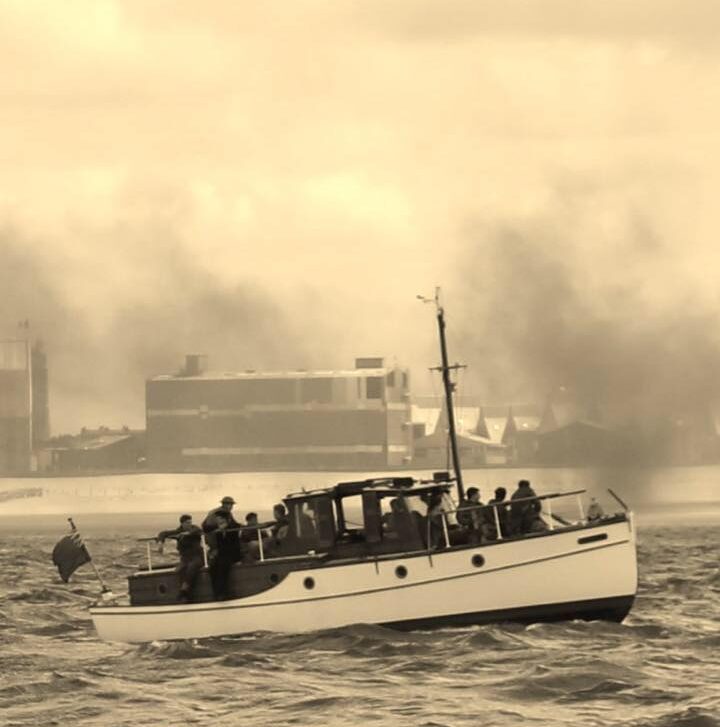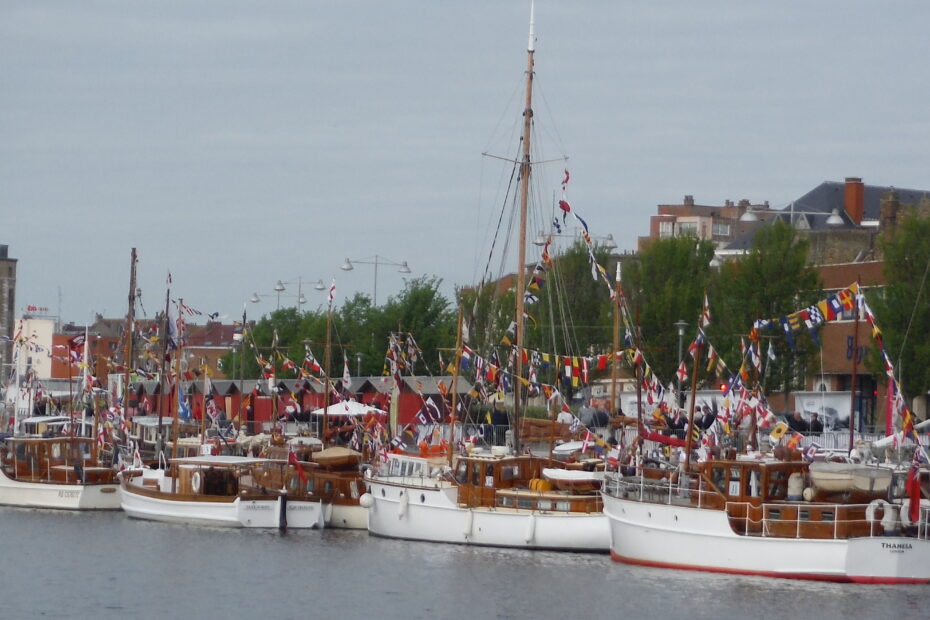After a brief introduction to the ‘Dunkirk Little Ships’ Keith Mosley shares his experiences of the 2015 Return to Dunkirk aboard ‘Papillon’. The event is run every five years to commemorate the 80th anniversary of ‘Operation Dynamo’ when over 300,000 troops were evacuated from the beaches of Dunkirk. ‘Papillon’ took part in filming ‘Dunkirk’, 2016.






Keith Mosley, owner of ‘Cordelia’, ADLS
In the ten days between 26 May and 4 June, 1940, the Royal Navy valiantly supported by the ‘Dunkirk Little Ships’, had evacuated British and French troops from the beaches and the Mole at Dunkirk. The ‘Little Ships’ were a rag-tag group of all sorts of craft, mainly river cruisers, fishing boats, Thames barges, trip boats and life boats, but all with one significant characteristic; they all had a shallow draught. They had been hastily gathered from the Thames and the ports surrounding the Thames Estuary, generally without their owner’s knowledge or permission. Apart from some of the fishing boats, they were manned by the Royal Navy and towed across to Dunkirk, where they were used to ferry the troops off the shallow beaches onto the destroyers and larger vessels waiting out in deeper water.
It was in his speech to Parliament describing the ‘success’ of Operation Dynamo in recovering more than 338,000 Allied troops from the beaches of Dunkirk that Winston Churchill gave his famous “We shall fight them on the beaches” speech. The Association of Dunkirk Little Ships (ADLS) was formed by Raymond Baxter, Commander Charles Lamb and John Knight after the first formal return to Dunkirk held in 1965. The ADLS is an even more exclusive ‘club’ than the OGA, qualification for full membership is to be the current owner of a proven Dunkirk Little Ship. The object of the Association is equally simple: to keep afloat for as long as possible as many as possible of the original Little Ships; to secure for them the honour to which they are entitled; and thereby to preserve “The Spirit of Dunkirk”.
Since 1965, the ADLS has made the ‘Return To Dunkirk’ to every five years. 2015 marked the 75th anniversary of the evacuation. It is unfortunate that there are now very few veterans of the evacuation who are still able to make the return, but those that do are given very special treatment by all involved. In 2015 two of the veterans, Michael Bentall and Garth Wright, made the crossing on Princess Frieda, one of the Dunkirk Little Ships. The remainder were taken across via EuroTunnel. Many of the boats that took part in the evacuation were gaff rigged sailing craft, there were numerous sailing fishing boats, a number of Thames barges, auxiliary ketches, motor yachts and lifeboats converted to sail. Two Thames barges took part in 2015, ‘Greta’ and ‘Pudge’, as did ‘Angele Aline’ a 65 foot Dundee fishing boat, ‘Letitia’ and ‘Endevour’, both Leigh Cockle boats, ‘Our Lizzie’, an auxiliary ketch from Cornwall and ‘Maid Marion’ a Cornish Lugger and ‘Stenoa’ a converted RNLI lifeboat. Most of the river cruisers carry a steadying sail to help reduce the rolling motion caused by their shallow draft in a heavy sea.
I am a member of the ADLS as I own ‘Cordelia’, a 38 foot river cruiser, but she was not ready to make the return in 2015. But an old pal, Ian Gilbert, the current Commodore of the ADLS, rang me and asked me to help him on the crossing. He owns ‘Papillion’, a 34 foot river cruiser. He would be ‘looking after’ the fleet so he wanted me to look after ‘Papillion’ which was leading the fleet on the crossing between Ramsgate and Dunkirk. The 2015 Return marked the culmination of many months effort by Ian and his team in arranging all aspects of the Return. The event actually started on the previous weekend when many of the boats taking part gathered alongside the Excel centre in London and left en-masse for Ramsgate. The weather gods were kind to us and ‘Papillion’ led the fleet on a smooth, un-troubled run down the Thames estuary, and though it did get a bit lumpy as we went around North Foreland, everybody arrived safe and sound and adjourned to one of Ramsgate’s many fish and chip emporiums for a well-deserved supper.
‘Operation Dynamo’ was run by Admiral Ramsey from the Dynamo Room of Dover Castle, hence the name, but the boats and the returning soldiers were landed at both Dover and Ramsgate, was well as many other ports around the Kent and Sussex coast. Ramsgate has become the departure point for the Dunkirk Returns largely because Dover is such a busy port, but also because Ramsgate provides a truly memorable occasion. On the Thursday morning the ADLS fleet and the accompanying craft formed up in ‘finger four’ formation (a homage to Raymond Baxter’s experience as a Spitfire pilot during the Battle of Britain) just outside the harbour entrance to the sounds of brass bands and the cheers of thousands of spectators. As we left along the Ramsgate Approach Channel we were buzzed by the Spitfire and Hurricane of the Battle of Britain Flight. The fleet was escorted by two Royal Navy Patrol Boats, ‘HMS Trumpeter’ and ‘HMS Ranger’, and the Ramsgate Lifeboat. His Royal Highness Prince Michael of Kent, who is Honorary Admiral of the ADLS was on board ‘HMS Trumpeter’. Also accompanying the fleet were four support and safety vessels in case of any breakdowns. The fleet is relatively slow by today’s standards, the maximum speed is a mere 8 knots, so it takes the large fleet a relatively long time crossing the main shipping channel. The Royal Navy Patrol Boats use their radar to help us cross the shipping channels by keeping an eye on the traffic and ‘requesting politely’ those boats that might be affected by the crossing to slow down or make minor alterations to their course well in advance of their arrival amongst the fleet. On a previous crossing one of the naval officers likened escorting the ADLS fleet to ‘escorting a flock of ducks across a motorway’.
Once again the weather gods smiled and we had a very easy and comfortable crossing to Dunkirk. The course is not straightforward with the Goodwin Sands and the sandbanks outside Dunkirk itself requiring a couple of doglegs in the course. We only made one minor mistake; being a former dinghy racer, I am used to getting quite close to the buoys, but that’s not a good idea when you have 40 odd boats astern of you and the strong tide setting you onto the buoy. But the buoy wasn’t significant only marking the division between the two separation channels rather than any obstruction so no great harm was caused, but the skippers had an exciting few minutes while trying to follow us around the buoy!! There was one minor problem for ‘L’Orage’, which had been Raymond Baxter’s boat, when the fuel tank came adrift and prevented fuel from getting in to the engine. Unfortunately this was then compounded when the support boat which took her in tow hit a lobster pot and fouled her prop, but it was all resolved stoically and the fleet was able to enter Dunkirk as planned.
As always the welcome is wondrous both from the French and the various Brits who join us in Dunkirk. The French lined the dockside clapping and cheering as we made our way to the Basin du Commerce in the centre of Dunkirk. Dunkirk itself puts on a maritime festival at the same time and various Brit re-enactment groups and military vehicle clubs join us in Dunkirk. And then there are the remaining Dunkirk veterans who lined the entrance to the dock and gave us a hero’s welcome. The weekend itself was full-on with numerous civic occasions, memorial service and receptions to attend. Ian and his wife Karina, seemed to be constantly either just coming back from an event or just going off to an event. Prince Michael of Kent was everywhere flying the flag and the Veterans were the stars of the show. Most of them are now well into their nineties and beyond; I have no idea where they get their energy from!
All too soon the weekend was over and we were due to return to Ramsgate. After one aborted attempt on the Monday when the smaller boats had to turn back because of the lumpy seas; we made our way homeward on the Tuesday morning in what turned out to be almost perfect weather. The larger boats had been able to continue to Ramsgate on the Monday to satisfy the large crowds that had turned up to welcome the fleet home. But there was no rest for the wicked and most of the fleet left again very early on the Wednesday morning to return back up the Thames. We got the navigation and the timings just right, arriving at the Richmond Tide lock just as they opened the gates. We finally reached Papillion’s mooring at Shepperton at about 0100 on the Thursday morning, very tired but very happy following a successful Return.
Keith Mosley, owner of ‘Cordelia’, ADLS
Find more about ‘Papillon’ on the ADLS website

You must be logged in to post a comment.